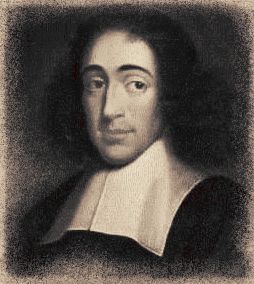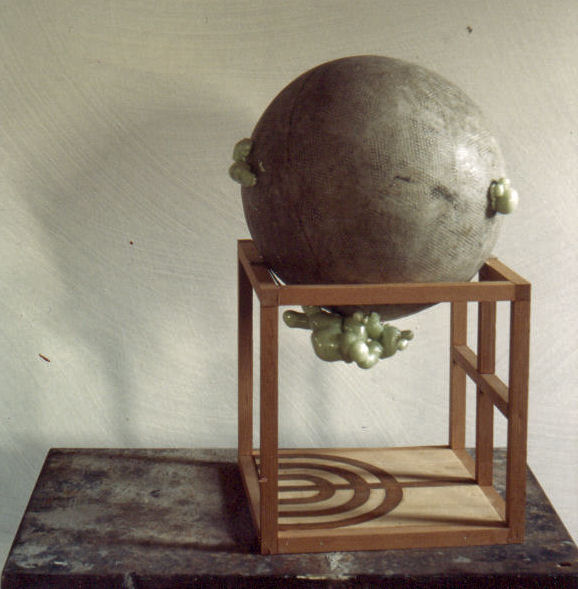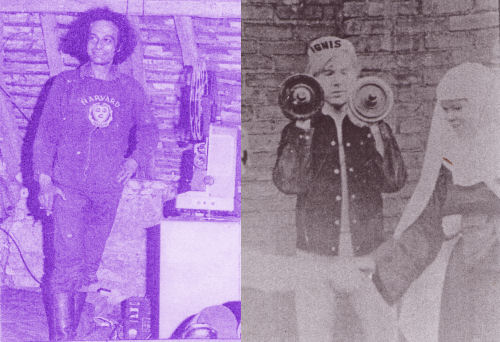|

|
 Nothing in nature is contingent, but all things are from the necessity of the divine nature determined to exist and to act in a definite way. Nothing in nature is contingent, but all things are from the necessity of the divine nature determined to exist and to act in a definite way.
The knowledge of an effect depends on, and involves, the knowledge of the cause.
Ethics, I, Proposition 29 and Axiom 4
Waldo Bien / Spinoza. by Muriel Rive, drawn from ‘A stone in flight’, publisher: Arti et Amicitiae, Amsterdam, 1997. ISBN 90-72612-21-3
When Waldo Bien wants to make a white painting, he first paints layer after layer of black and then works layer by layer towards white. Using diluted coal dust obtained from all parts of the world, he paints twenty or thirty layers from milky grey tones towards darker shades, mirroring the way day fades into night. In this way he obtains a black which has passed through all the stages of white, and the other way around. ‘Then you understand the black in terms of light and vice versa. Like you understand a photo from the negative. There too the positive image undergoes a process of transformation, the negative.
Black is a state of light and light is a state of darkness.’
Bien approaches art from an anthropological perspective. Applying a knowledge of the form processes undergone by man and matter, he delves his way through all layers of consciousness. Figuratively by penetrating through to knowledge and literally by processing the material with the help of the acquired understanding. In the example of the black painting this incorporates an entire process of consciousness.
Because what we perceive as black coal dust has its origins in the light falling on the plant. With its roots this brings up the darkness from the earth and at the same time penetrates it with light. Colour is created in the play between these two poles. As a result of death, time and compression the plant condenses its original being of light into darkness, eventually to become a being of light again in the diamond. ‘The essence of its own being’. It is a being of time itself from the knowledge of the physical matter, in this case coal, you also derive knowledge of the non-physical, such as light. There is nothing in the world of matter in which light is more incarnated than in diamond.’
In the past twenty-five years of Waldo Bien’s interdisciplinary research he has encountered many philosophers, including Spinoza. But at a certain moment (in 1982) Bien decided to relegate reason as driving force to the background. Instead of looking for a form or a content, he started searching for the content of the form. ‘Interdisciplinary research is a difficult discipline. You mustn’t want anything in particular and to begin with, you have to be very open, without expectations. Dip the brush into paint, lift it up to the paper, and let it happen. One should only permit the analytical consciousness to follow what has already happened, and to allocate it a  place. Then you notice that as soon as you change perspective all the content shifts too, changes kaleidoscopically and penetrates other cultures.’ place. Then you notice that as soon as you change perspective all the content shifts too, changes kaleidoscopically and penetrates other cultures.’
Applying his interdisciplinary research ‘methods’ he brings everything into mutual relationship. The symbiosis which can arise between different things is an important element of the work. During the process of research the form presents itself, so to speak. Sometimes it can take years before the meaning within the totality is revealed, but there are no coincidences. ‘The word says it all’, says Bien, referring to the Dutch word for ‘coincidence’: toeval (fall to), ‘something falls to you.’
‘Nothing happens without a cause. We’re directed by other forces than just our own. A large part of the time we do things we don’t even realize we’re doing. If you’re lost in thought, that doesn’t mean that you’ll walk into a lamppost. In such moments we’re guided by our automatic pilot. Sometimes there are encounters: the world lets something fall to us’. At such moments the question is whether you let it penetrate into your consciousness. Otherwise nothing will happen. These are messages from the same area which we enter with our intuition.’
During his travels Bien collects all sorts of materials, for instance from other (extinct) cultures. But he never just takes something with him because he finds it pretty. ‘It’s always material seen in a very broad context. The object I find already fits, or in retrospect forms part of an entire process of thought which slowly unfolds on the basis of the materials and objects, like a topographic marker within the conceptual field of image”.’
The various routes taken by Bien led him - from Goethe’s colour theory - to a treatise by Spinoza on the rainbow. This is a document, according to Bien, which Spinoza threw on the fire and about which nothing more is known. This therefore gives him complete freedom in his further approach to the subject. He enters the ‘empty space’ provided by Spinoza.
‘The way that Spinoza approaches things is strongly related to the ordering principle in my own work. ‘ But for Bien, rationality should not dominate the process from the very beginning. If you focus too strongly on the theoretical side of things, he believes, then you end up on the descriptive, superficial level too quickly. The danger here is that the ‘time’ is lost from the process which is needed to dig things up, so to speak. Matter is anchored in time and also needs a lot of time to be penetrated and read.
‘You have to place yourself in between these elements, like a prism, and thus allow knowledge to establish a link with subjective constituent parts of the individual. Then your art will blossom forth’.
The working process is not possible without thought, but it’s not just a question of thought either. It only becomes a concept at the moment that you’ve ‘checked’ and ‘cross-checked’ everything. We can see from the developmental phases of a child that something only becomes a concept when it can literally be grasped (to ‘grasp’ a concept).
In your imagination let your hand glide o’er the sculptures of Giacometti, Michelangelo and Brancusi. Then you really experience their true nature, their material secret. You won’t find it in any book, the eye can’t read it. The hand is an organ of speech and hearing. The hand, the thinker and grasper, is the organ with which I initially perceive. I’m always surprised by how clumsy or ‘unhandy’ philosophers are. They can think a nail into the wall, but they mostly can’t hit it. But Spinoza ground lenses too, whereby he integrated the hand in the process of thought and let his thoughts pass through his hand.’
One can say that Bien’s points of departure in art are related to Spinoza’s conditions for seeing things from the perspective of infinity.
According to Gaarder ‘... if we recognize that everything happens from necessity, we can achieve an intuitive understanding of nature as a whole. We can come to realize with crystal clarity that everything is related, even that everything is One. The goal is to comprehend everything that exists in an all-embracing perception. Only then will we achieve true happiness and contentment. This was that Spinoza called seeing everything “sub specie aeternitatis”.’2
Bien himself doesn’t call it eternity, but he does feel it necessary for art to move beyond the individual domain. He reduces basic terms to the human source from which they sprang and confronts this with what the terms have eventually become. The resulting consequences and insights then require one to act accordingly.
In addition to the ‘unconscious’ Spinozist elements, such as the awareness of a necessary bond between all elements and the striving for a holistic vision n which the nature of concepts and things is revealed, Bien’s work for this exhibition also contains direct references to the life of Spinoza.
‘Marranomap’ is the title of the installation, referring to the ‘Marranos’, the Jews baptized as Christians in Spain and Portugal. The open cube represents the conceptual space of reason and thought. It carries the world, and within it, the shadow of the Christian cross falls on the Jewish seven-armed candlestick, the menora. ‘It is the secret space within which Spinioza was a jew, within which his life arid thoughts took place, which we will never be able to understand. And the menora can also be viewed as a plan of Amsterdam.’
The menora on the horizontal base functions as trunk, as the roots of Spinoza. The ‘family tree’ also triumphs as the mid-point in the painted X-ray photo with the word ‘Heliczer’.
 ‘Heliczer’ is a surname which here functions as the trunk or stem of the images. In the ruin of an isolated house in Normandy, Bien found a pocket diary with literary notes by a certain Pierot Heliczer. Some of these concerned a house on the Lijnbaansgracht in Amsterdam which Bien walks past every day. ‘In the same pile of rubbish I found pots of blue-grey paint and a pile of X-ray photos of an unknown French woman. I was in Normandy, not involved in anything to do with Spinoza, involved in the rainbow. It rains rainbows there almost every day. So Spinoza himself came to me, he was simply already there.’ ‘Heliczer’ is a surname which here functions as the trunk or stem of the images. In the ruin of an isolated house in Normandy, Bien found a pocket diary with literary notes by a certain Pierot Heliczer. Some of these concerned a house on the Lijnbaansgracht in Amsterdam which Bien walks past every day. ‘In the same pile of rubbish I found pots of blue-grey paint and a pile of X-ray photos of an unknown French woman. I was in Normandy, not involved in anything to do with Spinoza, involved in the rainbow. It rains rainbows there almost every day. So Spinoza himself came to me, he was simply already there.’
Bien’s investigation revealed that Heliczer had been a cameraman for Andy Warhol in the New York Factory. Jewish, half Italian, became lost in France and was killed there in a road accident. Heliczer, as a Jew, was in principle not allowed to deal with images but nevertheless worked as a cameraman. A man of images. Chagall broke with tradition to be able to paint God and the angels. Spinoza, Chagall and Heliczer cut through their own umbilical cord.’
For the glass of the seven X-ray paintings Bien started a search for old window panes which were not rolled as sheets, but instead cast in the mould. Bien decided on this wave-form glass due to its optical relationship to liquids. ‘It isn’t comprised of ground lenses, but if you walk past it the images behind the glass move as if in waves. The pictures were also created in movement, in the growth process of the human body. The body is an individual universe, delineated by the skin, the skeleton of which we can see here on the X-ray photos, the supporting, architectonic construction of the human body. The skeleton is the hat stand of the philosophers, they hang their concepts on it.’
The use of colour in Bien’s ‘rainbow treatise’ is striking. It contains no red or yellow. This was a conscious decision because it is exactly through this absence that he can create a longing for the complementary colours. When one regards the pictures in their blue-grey quality, the missing colours appear in the mind as counterpart. These absent colours do however appear in a section of the ‘Marranomap’. The welded-together ‘Module’ segments are parts of chemical vats, originating from the Western world. Bien found them in Africa, bought them and had them and returned them to their region of origin. Although they were initially used as frames, he is now more interested in painterly colour formulas. The colours, in their original quality, contain direct references to the poisonous content.
Within the installations Bien shows possible illustrations from Spinoza’s treatise on the rainbow. They are a substitute for the lost text. The iconography of the illustrations consists here of several layers of image and consciousness. They are fixings of moments, thoughts’, notes and references to other perceptions. Bien worked all summer in Ireland, and subsequently in France, Normandy. In the process he primarily ‘read’ some things in a Celtic, Christian manner. Working in this perspective he provided the image with title and caption to ease it out of the Spinozan context and to extend the scope of the image. ‘Sometimes, in my mind, I add to the work by writing down how I read it all. You could also write it all the way round, like the commentaries on the original text in the Jewish tradition. Then... if necessary: another addition, a reduction, a fixing. All of it very relaxed, controlled, it’s a sort of Zen. Eventually the meaning may even transcend the intentions of the artist. Because with every change of context, the picture changes too.’
|
|